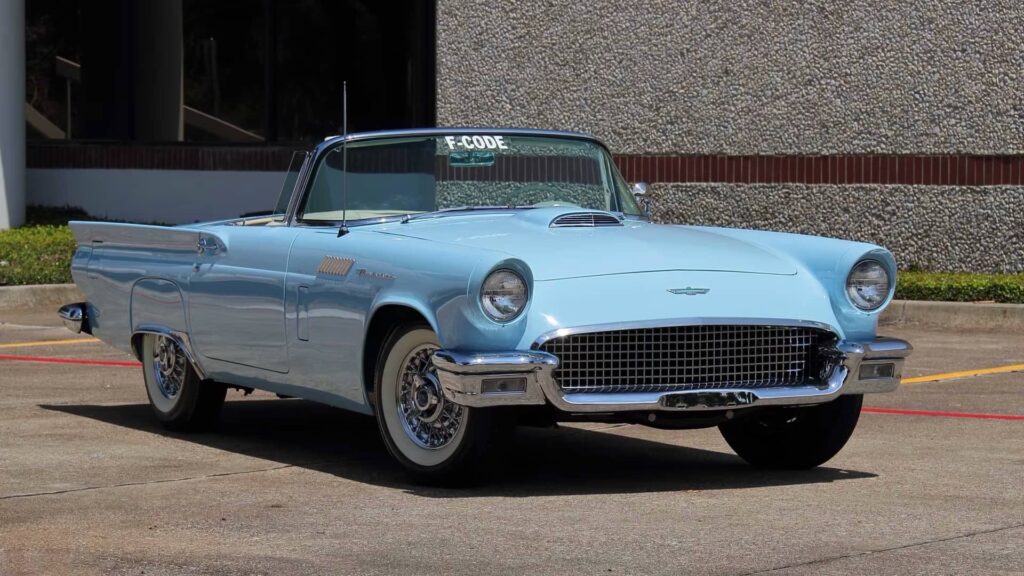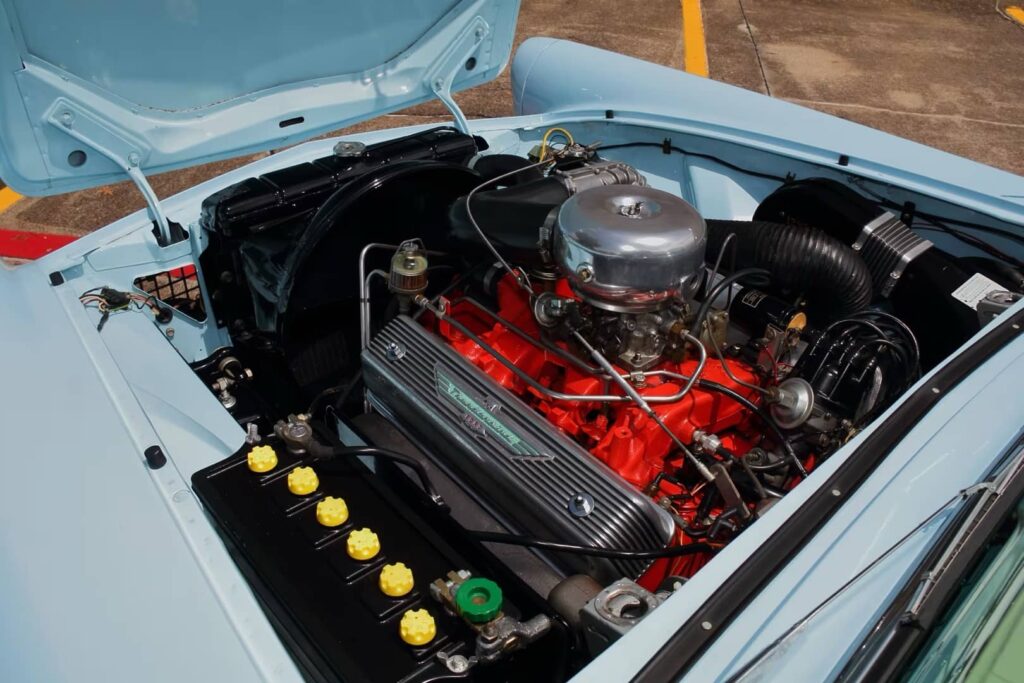First-Generation Ford Thunderbird
The first-generation Ford Thunderbird burst onto the American automotive scene as a two-seat convertible for the 1955 model year. Developed as Ford’s answer to the Chevrolet Corvette, the Thunderbird debuted in late 1954 and was an immediate success, outselling its rival significantly in its initial year. While it shared a sporty aesthetic with its competitor, Ford deliberately marketed the Thunderbird not as a raw sports car but as a “personal car of distinction” or a “personal luxury car,” emphasizing comfort, style, and V8 power over pure performance. This new focus on stylish, comfortable motoring for two carved out a unique and successful niche in the booming post-war American market.
Throughout its three-year run from 1955 to 1957, the first-generation Thunderbird underwent continuous, yet relatively minor, refinements. The 1956 model year introduced the iconic “porthole” windows as an option on the removable hardtop and moved the spare tire to a Continental-style exterior mount to increase trunk space. The final year of the original Thunderbird, 1957, brought styling updates like a reshaped front and lengthened rear, which allowed the spare tire to be moved back into the trunk.
Despite its popularity and rising sales, Ford executives, notably Robert McNamara, felt the two-seat configuration limited its market potential. This strategic decision led to the complete redesign of the Thunderbird into a four-seater for 1958, effectively ending the era of the classic two-seat Corvette competitor and cementing the first-generation’s status as a unique and highly prized collector’s item.
F-Code Thunderbird
The F-Code was Ford’s factory-built answer to Chevrolet’s fuel-injected C1 Corvette. It was equipped the 312-cubic-inch V8 with a McCulloch/Paxton VR57 centrifugal supercharger, officially rated at 300 horsepower, though many believe the true output was significantly higher. Built for NASCAR homologation, only around 196 of these supercharged “F-Birds” were ever produced.

Mecum will be offering an F-Code Thunderbird at their upcoming Dallas/Fort Worth Auction, one of only 16 that left the factory finished in Starmist Blue and equipped with the extremely desirable three-speed manual transmission. In light of their success earlier this year, selling an F-Code Thunderbird for $231,000 we’re going to take a look at the performance of the F-Code over the past few years.
F-Code Thunderbird Market Trends
Auction results from the three-year period reveals that F-Code Thunderbird values have remained relatively stable, declining only slightly by 1.8% on average. In late 2022 and throughout 2023, F-Code models averaged $155,280 at auction, while 2025 sales have averaged $152,560. This is a marginal decrease that contrasts positively with more dramatic corrections experienced by other 1950s American classics.
The median sale price tells a slightly different story, rising from $148,061 in the 2022-2023 period to $159,500 in 2025, showing that although lower-tier examples may have softened, quality F-Code Thunderbirds have matched or even exceeded market expectations.
Notable Sales
2023:
- A Bring a Trailer sale in March 2023 realized $102,222 for a Colonial White example with overdrive.
- Barrett-Jackson in Palm Beach sold an F-Code in April 2023 for $193,900 – significantly below its 2006 sale price of $319,000.
- RM Sotheby’s Amelia Island achieved $224,000 for a Raven Black F-Code from the Terence E. Adderley Collection.
2025:
- Barrett-Jackson sold an F-Code Thunderbird in Scottsdale for $159,500 in January.
- Mecum sold a phenomenal F-Code Thunderbird for $231,000 at their Kissimmee auction in January.
- The Sam Pack Collection sale by RM Sotheby’s saw a strong sale at $247,500 in February.
- GAA Classic Cars sold an F-Code for $105,000 in February.
- The Don Davis Collection from RM Sotheby’s saw an F-Code sell for $198,000 in August.
The wide range of prices – $102,000 to $247,500 – highlights how factors such as restoration quality, color rarity, awards, and documentation are key factors when it comes to F-Code valuations.
The Supercharged Option

What makes F-Code Thunderbirds so desirable is their factory-supercharged 312 cubic inch V8, equipped with a McCulloch/Paxton supercharger rated at 300 horsepower – although period tests indicated it was closer to 400 horsepower. The F-Code package added $340 to the Thunderbird’s base price, about a 12% premium. That lead to the F-Code cars being selected only by the performance-focused buyers as Ford partly built the F-Code cars to homologate the car for NASCAR racing.
Changing Demographics and a Changing Market
The past years have shown a shift in collector car demographics that have reshaped the market for 1950s classics. Baby boomers, who own more than half of the estimated 5 million classic cars in America, have been hitting retirement age and downsizing their collections. At the same time younger collectors – Gen X and Milliennials – have focused on cars from the 1980s, 1990s, and 2000s.
The transition between generations has presented challenges for classic cars from the 1950s. During Monterey Car Week in 2024 collector cars from before the 1980s with estimated prices in excess of $1 million demonstrated a roughly 50% sell-through rate compared with 73% for newer vehicles in the same price range.
However, F-Code Thunderbirds appear to be at least somewhat protected from the wider negative market trends. Their rarity appears to cross generational boundaries.
Restoration Quality and Awards
Auction results show that the quality of restoration can significantly affect F-Code Thunderbird values. The example that Mecum sold in January 2025 benefited from a 2,600 hour nut-and-bolt restoration that cost $200,000. It won multiple Classic Thunderbird Club International Gold Medallion awards with almost perfect scores of 298-298.5 out of 300 possible points.
That Flame Red Thunderbird demonstrates the premium that a concours-level restoration can command, compared to other F-Code Thunderbirds that require work or lack documentation that seem to have landed in the $100,000 – $120,000 range.
Color and Option Rarity
Factory color combinations can also strongly influence F-Code values. The most common colors were white and black, while just 16 were finished in Starmist Blue like the one that Mecum will offer at their Dallas/Fort Worth sale. Factory options also impact values with examples equipped with the three-speed manual transmission being a great deal more desirable than those equipped with automatic transmissions. Other options such as power accessories, the Town and Country radio, and original documentation also serve to strengthen prices.
Comparing to Other First-Generation Thunderbirds
It’s important to view F-Code values against the backdrop of other Thunderbird variants. Base-level 1957 Thunderbirds now change hands for $40,000 – $60,000 for quality vehicles. E-Code Thunderbirds, equipped with dual four-barrel carburetors that produce 270 horsepower, bring stronger prices around $60,000 – $85,000. The significant premium commanded by F-Code Thunderbirds, as much as 4x the price of base models, reinforces their status as the best of the first-generation Thunderbirds. That premium has stayed relatively consistent over the past three years, seeming to suggest that collectors of all ages still recognize the significance of the supercharged model.
Conclusion
The past three years, from October 2022 through October 2025, have seen F-Code Thunderbird values show significant resilience in the face of changing demographics. In the near term we expect F-Code Thunderbirds to remain stable thanks to their scarcity and a still strong base of Thunderbird enthusiasts. However, long-term values really depend on whether or not younger generations will embrace these cars or if they will end up depending on an aging group of baby boomer collectors. Right now the F-Code Thunderbirds are still bringing prices in excess of $200,000, quite the statement as to their longevity almost seventy years after they left the factory.
